|
 Re: red line dash ammeter by pass
[Re: Supercuda]
#2623603
Re: red line dash ammeter by pass
[Re: Supercuda]
#2623603
02/20/19 05:32 AM
02/20/19 05:32 AM
|
Joined: May 2006
Posts: 1,754
Phila
PhillyRag

top fuel
|

top fuel
Joined: May 2006
Posts: 1,754
Phila
|
What Chrysler made after 1975 is replace the full load ammeter for a shunted ammeter system which it works like somehow of remote ammeter. The ammeter got an amplifier coil to increase magnetic field able to move the needle with a minimal load going parallel to a shunt wire ( on engine bay ) offering a slight resistance to the charging system which allowed to get some minimal load going through the shunted ammeter. But not a resistor on ammeter really.
Ammeter NEVER READS VOLTAGE... just magnetic fields variation caused by electrons which feed the load requirements
https://en.wikipedia.org/wiki/Shunt_(electrical)#Use_in_current_measuring "An ammeter shunt allows the measurement of current values too large to be directly measured by a particular ammeter. In this case, a separate shunt, a resistor of very low but accurately known resistance, is placed in parallel with a voltmeter, so that all of the current to be measured will flow through the shunt. The resistance is chosen so that the resultant voltage drop is measurable, but low enough not to disrupt the circuit. The voltage across the shunt is proportional to the current flowing through it, and so the measured voltage can be scaled to directly display the current value." https://en.wikipedia.org/wiki/Current_sensing#Shunt_resistors"Ohm's Law is the observation that the voltage drop across a resistor is proportional to the current going through it. This relationship can be used to sense currents. Sensors based on this simple relationship are well known for their lower costs, and reliability due to this simple principle. " Nacho understands very well differences between types of ammeters. One is a Direct reading, other is not (i.e. Shunt). A shunt ammeter IS a volt meter which INDIRECTLY indicates amperage (ie via voltage drop across shunt).
|
|
|
 Re: red line dash ammeter by pass
[Re: moparpro]
#2623618
Re: red line dash ammeter by pass
[Re: moparpro]
#2623618
02/20/19 10:21 AM
02/20/19 10:21 AM
|
Joined: Aug 2007
Posts: 6,095
Valencia, España
NachoRT74

master
|

master
Joined: Aug 2007
Posts: 6,095
Valencia, España
|
Maybe if you get an ammeter going from 0 up to X value, can be measured in Volts and reflected as ammeter due the proportionally between volts and amps with a known resistance value ( Ohms law ). This can be measured getting just one power source and one device sucking it on the opposite side BUT if you ask me not with an ammeter reading Charge and Discharge with two power sources one on each side being one an acumulator and the other one a generator, with needle in center, because you can't read negative voltages. There is or there is not voltage, but never negative voltage able to sway the needle to the reverse side. Voltage is allways present in all the system without care where is going the current.
You have allways same voltage on all the system, but not necessarily current if there is not devices sucking it.
Our car ammeters are able to read what is coming or going from/to batt, and thats allways a positive flow, in one or other direction. An ammeter based on volts measurement won't be able to make that.
That's at least what I can see. I have a shunt ammeter in hands ( M body Lebaron ) and is exactly the same piece ( but smaller pieces ) than a full load unit with just the coil installed to amplify the fields able to move the needle, so is still magnetic device. Needle still mounted on a brass counterweight what will move in one or the other direction according to magnetic field variation given by the current flow.
Anyway, the diff ammeter design systems are not related to how to make efficiently work the charging system on our cars still keeping the stock system safe without need to bypass more than the weakness of terminals. Packard terminal weakness are there with ANY alternator you use, because no matter which one is the source ( Batt or alt ) if you car sucks 40 amps, will suck it from any source available. If your batt gets discharged, then your car will become on a maybe 60 amps sucker from alt and thats what we have to save with agood alt, to never get a discharged batt. This is so real, than our cars got melted those terminals with low capacity alts. The alt upgrade is just to keep safe the ammeter from loads coming and going simply eliminating the batt as a sucking device of the game. The bulkhead bypass OR doubling the paths will increase the handling capacity of the system to feed it, and still able to do it if batt gets discharged at certain point.
Is like a baby sucking milk! If is hungry, will cry and suck untill gets satisfied, no matter if from a boob or a bottle, maybe two bottles or both boobs. But it needs to get satisfied. If you have twins will be worst, so, keep safe from get the second baby sucking ( batt ) and will need less milk and less stress
Last edited by NachoRT74; 02/21/19 05:53 PM.
With a Charger born in Chrysler assembly plant in Valencia, Venezuela
|
|
|
 Re: red line dash ammeter by pass
[Re: moparpro]
#2623931
Re: red line dash ammeter by pass
[Re: moparpro]
#2623931
02/20/19 09:59 PM
02/20/19 09:59 PM
|
Joined: Feb 2010
Posts: 1,645
Phila. Pa.
Mattax

top fuel
|

top fuel
Joined: Feb 2010
Posts: 1,645
Phila. Pa.
|
what alternator would you recommed 69 dodge 383 eng. thanks Stock? Stock as in points ignition, mechanical fuel pump, engine driven fans, etc. If so, there is very little electric load. A stock alternator will do OK. Aftermarket most will be called "60 amp" or something close to that. With the headlights on at a stop, especially with an automatic, you may see the battery take over. If that bothers you, or this is frequently the situation, then get a 'squareback' alternator. The squarebacks of the same 'rating' generally provide a bit more current at idle speeds. A squareback will need one field terminal grounded since your car has the positive controlling voltage regulator. If the car has A/C and you do a a lot of idling with it on, or with lights and heater and wipers on, then prob want an alternator with more output at idle. Nacho and others already covered this. nacho, if wiring from scratch [think hotrod, custom harness, no bulkhead plugs], how would you tie in an amp meter ? same as the factory method plus using the bypass ? volt gauge will also be in use.  Well I'm not Nacho  but IMO it all depends on what you are building in terms of electric loads and supply. A system with internally shunted ammeter really requires just one fusible link. This means the alternator's output doesn't have to run through a restriction. However if the hot rod is going to be running equipment off of the battery for some of the time, such as EFI, electric pump, electric fans, then a design with an internally shunted ammeter doesn't make sense. actually the fuse link must be rated to the nominal car load and not the alt Exactly. Whether its a fuse, breaker, or fusible link it must be sized to be weaker than the weakest unprotected wire or device downstream. The fusible links are mostly to protect against the battery burning everything between it and a short. The advantage of a link is it can handle moderately high loads. For exampple, immediately after starting the battery may draw 30 - 40 amps for a few seconds. Maybe Nacho will find that video. Is like a baby sucking milk! If is hungry, will cry and suck untill gets satisfied,  A good analogy! Here's a time lapse sequence of charging a battery that is around 50% low. Notice how much it sucks when supplied at 14.2 Volts. Fortunately with a charger we can reduce that. https://www.forabodiesonly.com/mopar/thr...post-1972341430This is why recharging very low batteries can hurt a lot of stuff, not just the wiring between the alternator and the battery. It's also hard on the alternator wiring and can cook the battery.
Last edited by Mattax; 02/20/19 10:03 PM.
|
|
|
 Re: red line dash ammeter by pass
[Re: R/T1968R/T]
#2623992
Re: red line dash ammeter by pass
[Re: R/T1968R/T]
#2623992
02/20/19 11:55 PM
02/20/19 11:55 PM
|
Joined: Aug 2007
Posts: 6,095
Valencia, España
NachoRT74

master
|

master
Joined: Aug 2007
Posts: 6,095
Valencia, España
|
The welded spice where they connect together inside the car is the main distribution point.
and this TRUE statement is why I hate THIS link: where they say AS A FALSE STATEMENT with their job the main splice is being moved out to the starter relay stud... WHICH IS NOT
With a Charger born in Chrysler assembly plant in Valencia, Venezuela
|
|
|
 Re: red line dash ammeter by pass
[Re: NachoRT74]
#2624022
Re: red line dash ammeter by pass
[Re: NachoRT74]
#2624022
02/21/19 12:34 AM
02/21/19 12:34 AM
|
Joined: Feb 2010
Posts: 1,645
Phila. Pa.
Mattax

top fuel
|

top fuel
Joined: Feb 2010
Posts: 1,645
Phila. Pa.
|
The welded spice where they connect together inside the car is the main distribution point.
and this TRUE statement is why I hate THIS link: where they say AS A FALSE STATEMENT with their job the main splice is being moved out to the starter relay stud... WHICH IS NOT You can say that again. But it gets worse. They recommend a 'fix' that routes all of the power to the run the car through two fusible links in series.  The only thing it addresses, although poorly, is the problem created when running a winch or a plow. (These are usuallly tapped in at the battery because they draw so much power)
|
|
|
 Re: red line dash ammeter by pass
[Re: Mattax]
#2624127
Re: red line dash ammeter by pass
[Re: Mattax]
#2624127
02/21/19 11:35 AM
02/21/19 11:35 AM
|
Joined: Aug 2007
Posts: 6,095
Valencia, España
NachoRT74

master
|

master
Joined: Aug 2007
Posts: 6,095
Valencia, España
|
It is true that they have moved the location of both feed lines to meet at the starter relay stud. So that becomes the primary feed point for whichever is supplying power. But it all still needs to get to the original main splice. So it does not good unless the main goal is charging batteries.  but that becomes it on a buss or junction point. Just 3 feet more and will reach the batt if relay is at firewall LOL and just one foot being at a side of the batt
With a Charger born in Chrysler assembly plant in Valencia, Venezuela
|
|
|
 Re: red line dash ammeter by pass
[Re: Mattax]
#2624211
Re: red line dash ammeter by pass
[Re: Mattax]
#2624211
02/21/19 02:40 PM
02/21/19 02:40 PM
|
Joined: Jan 2003
Posts: 15,357
Omaha Ne
TJP

I Live Here
|

I Live Here
Joined: Jan 2003
Posts: 15,357
Omaha Ne
|
Here's a typical 60s Chryco wiring strategy stripped down to the main feeds and their connections.
There is one feed from the alternator (starts with wire R6)
There is one feed from the battery (starts with wire A1A)
Power will come from either the Battery or the Alternator and then go to where ever a circuit is complete.
The welded spice where they connect together inside the car is the main distribution point.
Another question on the same subject. Looking at Mattax's 1st (simplified) diagram, Shouldn't the alternator battery wire/circuit also be fused ?? Lets say the car is driving down the road and there is a short that blows the fusible link. That will isolate the battery, but the alternator will continue to back feed the short as long as the engine stays running. That in turn would cause a meltdown, Correct ?? or am I missing something 
|
|
|
 Re: red line dash ammeter by pass
[Re: TJP]
#2624251
Re: red line dash ammeter by pass
[Re: TJP]
#2624251
02/21/19 03:48 PM
02/21/19 03:48 PM
|
Joined: Feb 2010
Posts: 1,645
Phila. Pa.
Mattax

top fuel
|

top fuel
Joined: Feb 2010
Posts: 1,645
Phila. Pa.
|
Here's a typical 60s Chryco wiring strategy stripped down to the main feeds and their connections.
There is one feed from the alternator (starts with wire R6)
There is one feed from the battery (starts with wire A1A)
Power will come from either the Battery or the Alternator and then go to where ever a circuit is complete.
The welded spice where they connect together inside the car is the main distribution point.
Another question on the same subject. Looking at Mattax's 1st (simplified) diagram, Shouldn't the alternator battery wire/circuit also be fused ?? Lets say the car is driving down the road and there is a short that blows the fusible link. That will isolate the battery, but the alternator will continue to back feed the short as long as the engine stays running. That in turn would cause a meltdown, Correct ?? or am I missing something  Lets draw that out. Added the field supply and ignition to show the power keeping things running. Engine is running with power coming from the alternator at 14 volts. Battery is charged. What happens when there is a short in wire connected to the main splice? Lets say the wire to the headlight switch rubs against a brace long enough the insulation gets worn through. 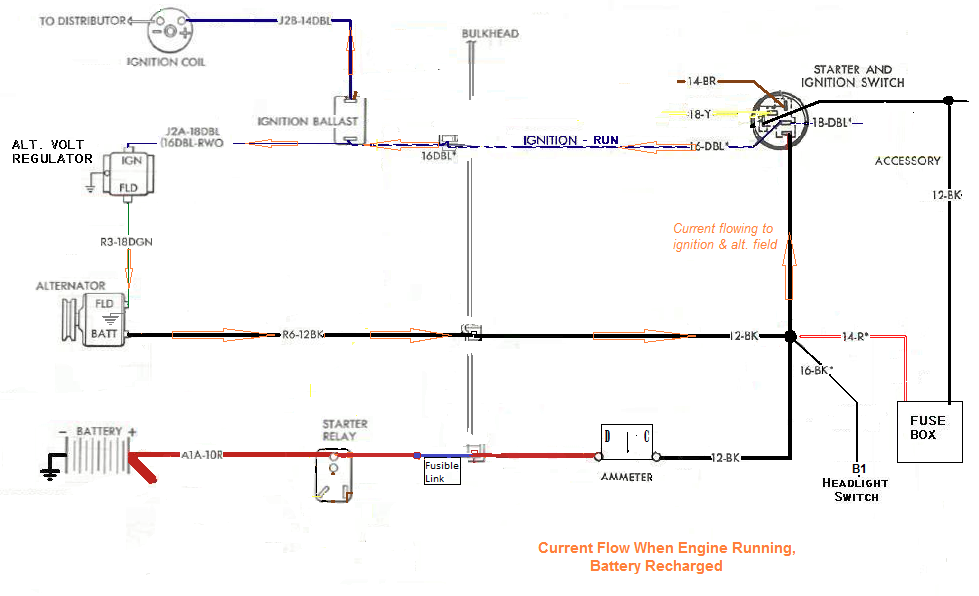 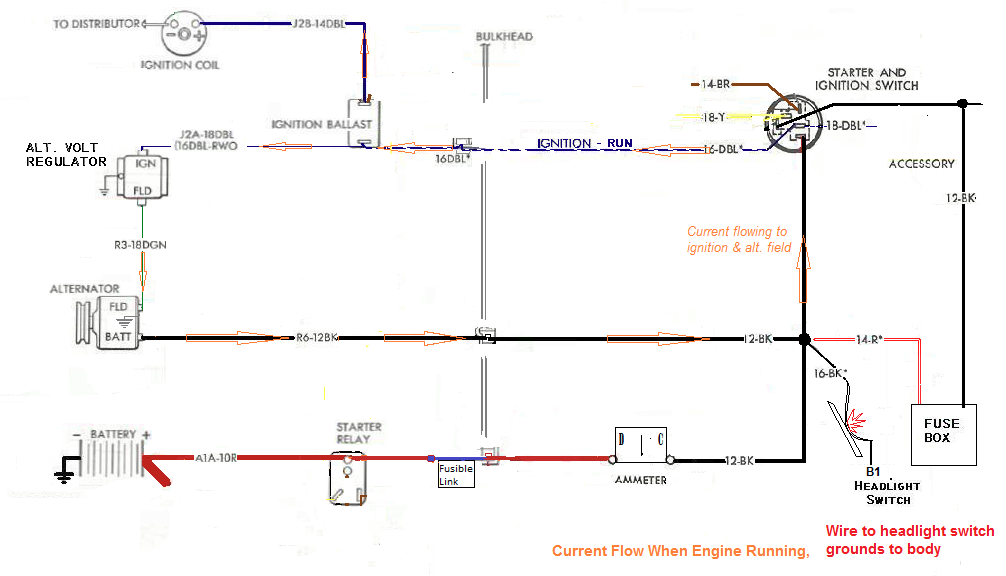
|
|
|
 Re: red line dash ammeter by pass
[Re: TJP]
#2624257
Re: red line dash ammeter by pass
[Re: TJP]
#2624257
02/21/19 04:06 PM
02/21/19 04:06 PM
|
Joined: Aug 2007
Posts: 6,095
Valencia, España
NachoRT74

master
|

master
Joined: Aug 2007
Posts: 6,095
Valencia, España
|
Another question on the same subject. Looking at Mattax's 1st (simplified) diagram, Shouldn't the alternator battery wire/circuit also be fused ?? Lets say the car is driving down the road and there is a short that blows the fusible link. That will isolate the battery, but the alternator will continue to back feed the short as long as the engine stays running. That in turn would cause a meltdown, Correct ?? or am I missing something  as I already have told previously. The only power source able to feed a short is the battery. If the fuse link blows the current coming from batt on a short, once fuse blows if short still goes on, the engine will stall. Any short will take all the power, so the regulator won't get enough power to feed the alternator and keep the system going. you can try it easily. Crank up the engine, disconect the bat and make a short anywhere... try it between alt stud and body for easier experiment and safer for the rest of the wiring. Engine will stall and with batt disconected, fuse link won't blow because there is not a source there to blow it up, but engine will stall
With a Charger born in Chrysler assembly plant in Valencia, Venezuela
|
|
|
 Re: red line dash ammeter by pass
[Re: NachoRT74]
#2624287
Re: red line dash ammeter by pass
[Re: NachoRT74]
#2624287
02/21/19 04:49 PM
02/21/19 04:49 PM
|
Joined: Jan 2003
Posts: 15,357
Omaha Ne
TJP

I Live Here
|

I Live Here
Joined: Jan 2003
Posts: 15,357
Omaha Ne
|
Nacho, Hola soy la esposa de TJP. Yo vivio en Lima por tres anos. El dice que tu sabes mucho y es un buen amigo. Thanks Nacho, 
|
|
|
 Re: red line dash ammeter by pass
[Re: NachoRT74]
#2624297
Re: red line dash ammeter by pass
[Re: NachoRT74]
#2624297
02/21/19 05:15 PM
02/21/19 05:15 PM
|
Joined: Feb 2010
Posts: 1,645
Phila. Pa.
Mattax

top fuel
|

top fuel
Joined: Feb 2010
Posts: 1,645
Phila. Pa.
|
Any short will take all the power, so the regulator won't get enough power to feed the alternator and keep the system going. Same with the engine's ignition. (So even with a self-feeding alternator, the engine will almost always die.) Here's the graphic sequence of "Any short will take all the power"  In fact most likely the power from the alternator is first to be diverted because it is at higher voltage. But this only momentary. 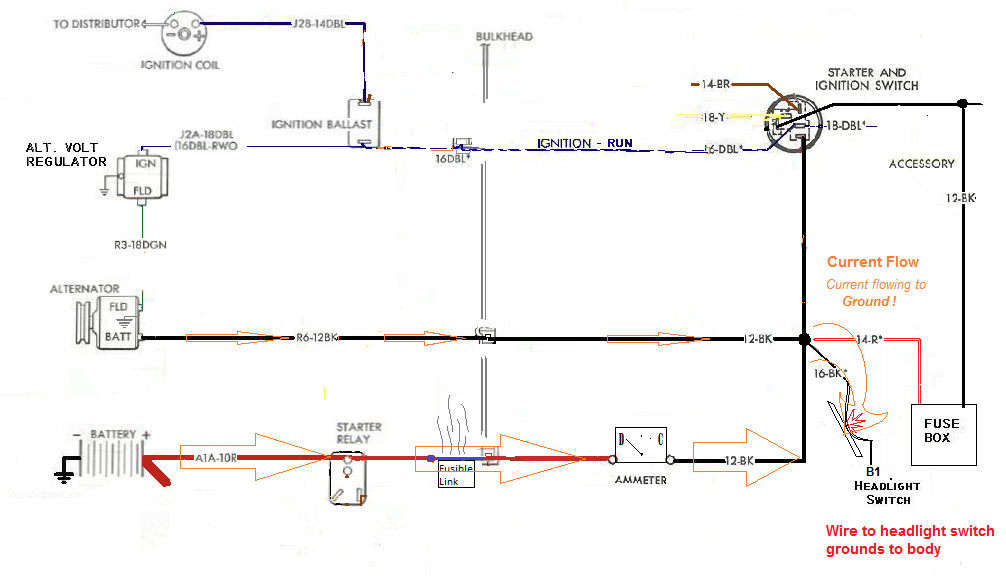 Short, first second Short, first second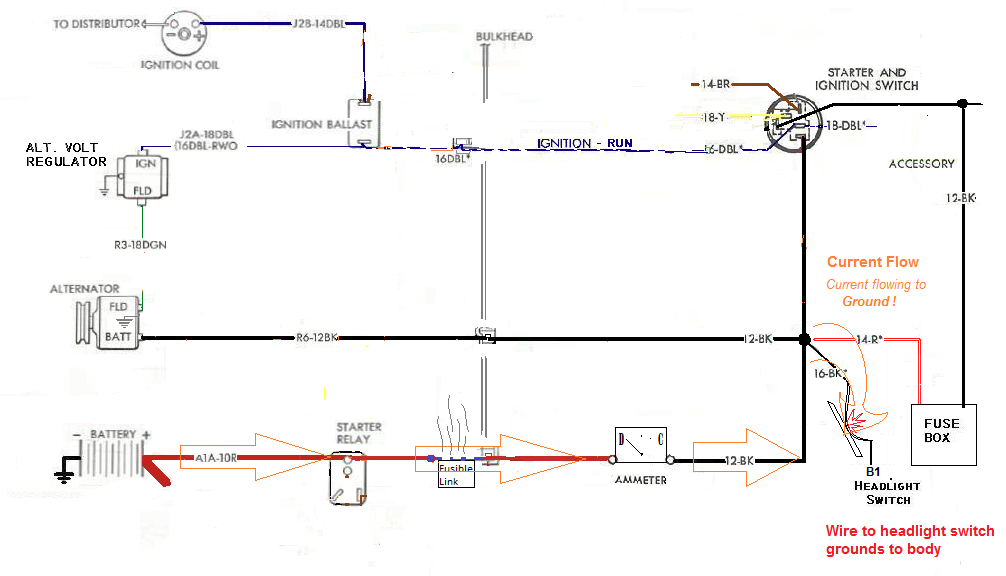 Short before link burns through Short before link burns through
Last edited by Mattax; 02/21/19 05:23 PM.
|
|
|
 Re: red line dash ammeter by pass
[Re: TJP]
#2624305
Re: red line dash ammeter by pass
[Re: TJP]
#2624305
02/21/19 05:46 PM
02/21/19 05:46 PM
|
Joined: Aug 2007
Posts: 6,095
Valencia, España
NachoRT74

master
|

master
Joined: Aug 2007
Posts: 6,095
Valencia, España
|
Nacho, Hola soy la esposa de TJP. Yo vivio en Lima por tres anos. El dice que tu sabes mucho y es un buen amigo. Thanks Nacho,  Gracias! La verdad no es que sepa MUCHO, pero comparto lo que he aprendido con todos los que quieran. Trato de ser buen amigo con todos! nuevamente, gracias!  Any short will take all the power, so the regulator won't get enough power to feed the alternator and keep the system going. Same with the engine's ignition. (So even with a self-feeding alternator, the engine will almost always die.) True, forgot about the self-excited alternators
Last edited by NachoRT74; 02/21/19 05:47 PM.
With a Charger born in Chrysler assembly plant in Valencia, Venezuela
|
|
|
 Re: red line dash ammeter by pass
[Re: Mattax]
#2624313
Re: red line dash ammeter by pass
[Re: Mattax]
#2624313
02/21/19 05:57 PM
02/21/19 05:57 PM
|
Joined: Aug 2007
Posts: 6,095
Valencia, España
NachoRT74

master
|

master
Joined: Aug 2007
Posts: 6,095
Valencia, España
|
what alternator would you recommed 69 dodge 383 eng. thanks Stock? Stock as in points ignition, mechanical fuel pump, engine driven fans, etc. If so, there is very little electric load. A stock alternator will do OK. Aftermarket most will be called "60 amp" or something close to that. With the headlights on at a stop, especially with an automatic, you may see the battery take over. If that bothers you, or this is frequently the situation, then get a 'squareback' alternator. The squarebacks of the same 'rating' generally provide a bit more current at idle speeds. A squareback will need one field terminal grounded since your car has the positive controlling voltage regulator. If the car has A/C and you do a a lot of idling with it on, or with lights and heater and wipers on, then prob want an alternator with more output at idle. Nacho and others already covered this. Sock alt but later, not the 69 one which barelly gets 22-28 amps at iddle. As I mentioned, any alt able to feed at least 45 amps at iddle. The more, the better, but on a basic car, no les than 45 amps iddling.
With a Charger born in Chrysler assembly plant in Valencia, Venezuela
|
|
|
 Re: red line dash ammeter by pass
[Re: moparpro]
#2624363
Re: red line dash ammeter by pass
[Re: moparpro]
#2624363
02/21/19 07:52 PM
02/21/19 07:52 PM
|
Joined: Aug 2007
Posts: 6,095
Valencia, España
NachoRT74

master
|

master
Joined: Aug 2007
Posts: 6,095
Valencia, España
|
well, not in my experience LOL. I have being able to recharge a death battery with my alt iddling and ammeter marking maybe 20 amps on charge side for about 20 minutes ( with a 80 amps alt ), and still quite cold studs. I was able to rev it up and needle still at same mark. Not on first 3 to 5 minutes thought. Remember, as you know, amperes can't be pushed in, so the batt will suck what it needs at the speed he can get recharged. You can't force to the acid to be faster sucking power than it can.
What I did on the first 5 minutes is turn on the lights to keep safer the ammeter.
and, remember the main and initial problem was just right the stock alts outputs back in the days.
would need to consider the pulley size too, because not every iddle speed could be the same speed to the alt
With a Charger born in Chrysler assembly plant in Valencia, Venezuela
|
|
|
 Re: red line dash ammeter by pass
[Re: NachoRT74]
#2624674
Re: red line dash ammeter by pass
[Re: NachoRT74]
#2624674
02/22/19 01:46 PM
02/22/19 01:46 PM
|
Joined: Feb 2010
Posts: 1,645
Phila. Pa.
Mattax

top fuel
|

top fuel
Joined: Feb 2010
Posts: 1,645
Phila. Pa.
|
Nacho, Just because you got away with it does not make it good all the time.  I have too, but with my agm it got hot, and later the stator failed. Maybe related, maybe not. That story I posted here: https://www.forabodiesonly.com/mopar/threads/charging-battery-with-alternator-warning.424783/You have also modified your system with parallel feed lines. A stock '68 or '69 B-body will be feeding only through the Packard 58 type connector as you know. You can turn on 20 amps worth of equipment in addition to 25 amps of charging and not overheat the connectors.  A quick illustration for those who have not seen Nacho's parallel wire strategy. Except in this diagram its only a parallel alternator outfeed wire. This is similar to some Chrysler fleet and heavy duty arrangements. I will be doing this soon to my Barracuda.  In the drawing, the alternator is shown supplying 45 amps at 14.2 Volts. Twenty amps goes to the battery by the shortest route with least restriction. As a result, no more than 25 amps goes though the bulkhead connector. This is much better because generally those terminals can not easily flow 45 amps and start to get hot. 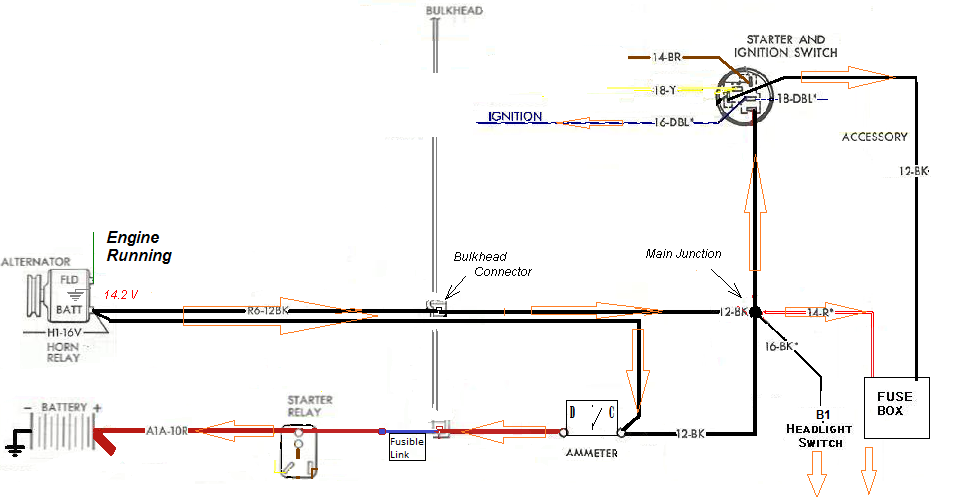 Parallel Alternator Output during high charge. Parallel Alternator Output during high charge.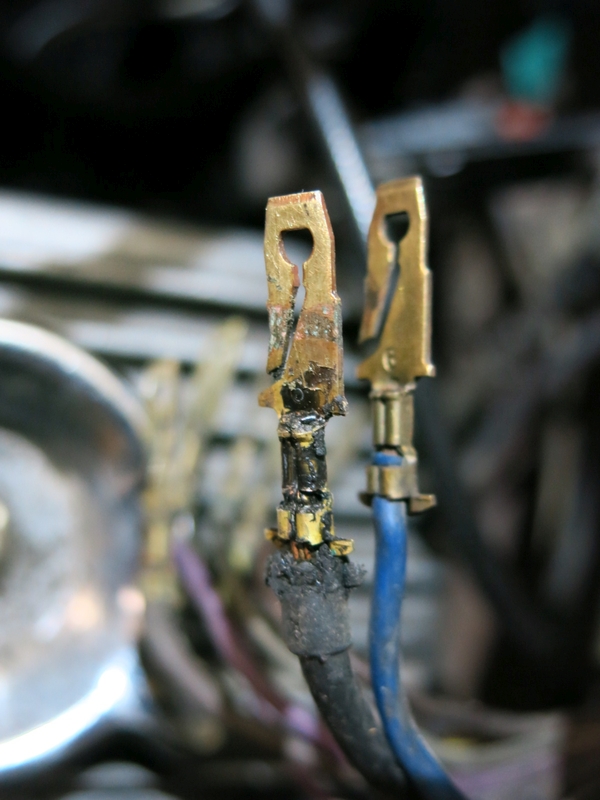 Heavy insulation melted back on bulkhead connector terminal for alternator output wire.
(Note: This is a repop, not original) Heavy insulation melted back on bulkhead connector terminal for alternator output wire.
(Note: This is a repop, not original)
|
|
|
|
|

